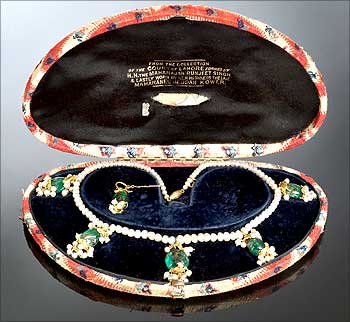Angelica Jopson in London
The emerald and seed pearl necklace from the Lahore treasury, reputedly worn by Maharani Jindan Kaur was, bought for around $88,000 (a little over Rs 4.1 million) at a London auction recently.
The buyer, Peter Verdi, is adamant that it must return home to India.
"I am relieved that the necklace is back in a Sikh family," he said.A gift for Queen Victoria
Image: A statue of Maharaja Ranjit Singh in Amritsar.It was taken away as a gift for Queen Victoria along with the priceless Koh-i Noor and the Timur Ruby.
This extraordinary necklace comes from the collection of Maharaja Ranjit Singh and Maharani Jindan Kaur (1817-63), which was sold by Frazer and Hawes from Garrards, Regent Street, London.
"It was very depressing the way the whole thing played out," said Verdi, "but it is in its right place now and we should put it all behind us."
When history went under the hammer
Image: The priceless necklace.After tremendous interest, the auction house expected bids for the item to reach up to $95,000 (over Rs 4.4 million).
Jindan was Maharaja Ranjit Singh's 17th wife and bore him a son, Duleep, just ten months before he died.
She was his only surviving widow, rejecting the practice of 'Sati' or throwing herself on the funeral pyre with his other wives, choosing to bring up her young son instead.
A chapter in history ends in Lahore
Image: Ranjit Singh's mausoleum in Lahore.In 1846, she was deposed as Regent and in February 1847, the British took possession of Lahore.
The British continued to see her as a major threat to their control of the Punjab as she was instrumental in organising the Sikh resistance.
Her son Duleepwas sent away from the palace and she was incarcerated in the fort at Sheikhurpura.
She later escaped and lived in exile in Nepal before being allowed to move to England to live with her son, who had been adopted as a godson by Queen Victoria and brought up as a young English gentleman.
Maharani Jindan Kaur died in August 1863 in her Kensington home in the country of her sworn enemy. Her body was brought back to India in 1864 and her ashes taken to Lahore in 1924.
Readers may recall Indian diplomat Navtej Sarna's elegant novel, The Exile, which chronicled Maharaja Duleep Singh's sad life.





article